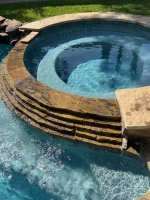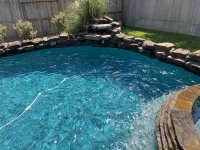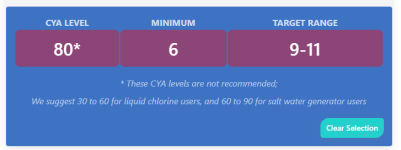I inherited a chlorine pool when we purchased our house in south Texas a few years back. I bought a Taylor K2006 test kit and have been using that to monitor levels every 2-3 days. Unfortunately, I've maintained the guidance/recommendations from Leslie's, which I now realize was a mistake that resulted in an rather poor experience... particularly around adding chemicals. With the Texas heat as it is right now, I've been using 1-2 tabs a week and supplementing with 70% cal hypo when the FC drops low. I've found myself continually battling algae, which hasn't been horrible, but has been quite tenacious and consumes more time than I'd like. pH swings are also an issue because of high TA levels (which were maintained around 80-ish when adjusted according to the pool store recommendations). To make matters worse, the spa has a spillway that adds to the problem. This week I've been in the process to fixing the pool chemistry and leveraging the TFP methodology, which has raised a few concerns around the liquid chlorine aspect.
I will likely need 3-5 gallons of liquid chlorine (10%) to get through the week. We have a curious toddler running around right now so I'm not sure it makes sense to keep in the house where I can better control the loss of potency. This means I would be keeping it outside in the garage where the temps are consistently over 100F because it's not insulated. This has made me wonder if I'd be better off converting to SWG and easing that burden. My particular issue is around whether or not my pool is compatible... It was built in 2011 and has a considerable amount of rocks (not sure what type), built into the spillway and around the edge of a good one-third of the pool perimeter. Would it be a mistake to convert to a SWG? Pictures are worth a thousand words, so here's what I'm working with.


I will likely need 3-5 gallons of liquid chlorine (10%) to get through the week. We have a curious toddler running around right now so I'm not sure it makes sense to keep in the house where I can better control the loss of potency. This means I would be keeping it outside in the garage where the temps are consistently over 100F because it's not insulated. This has made me wonder if I'd be better off converting to SWG and easing that burden. My particular issue is around whether or not my pool is compatible... It was built in 2011 and has a considerable amount of rocks (not sure what type), built into the spillway and around the edge of a good one-third of the pool perimeter. Would it be a mistake to convert to a SWG? Pictures are worth a thousand words, so here's what I'm working with.


Last edited by a moderator:


